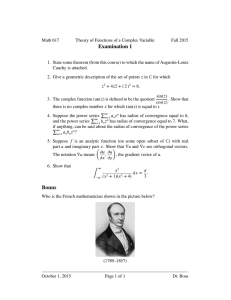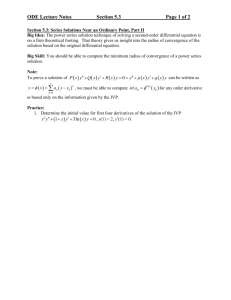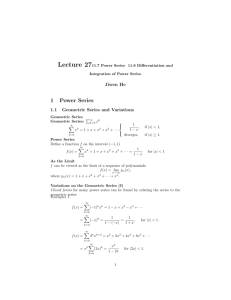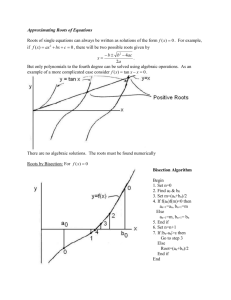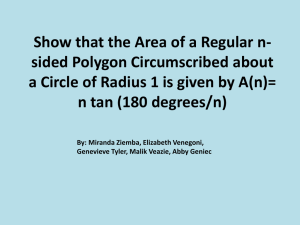4.6. Representation of Functions as Power Series We have already
advertisement
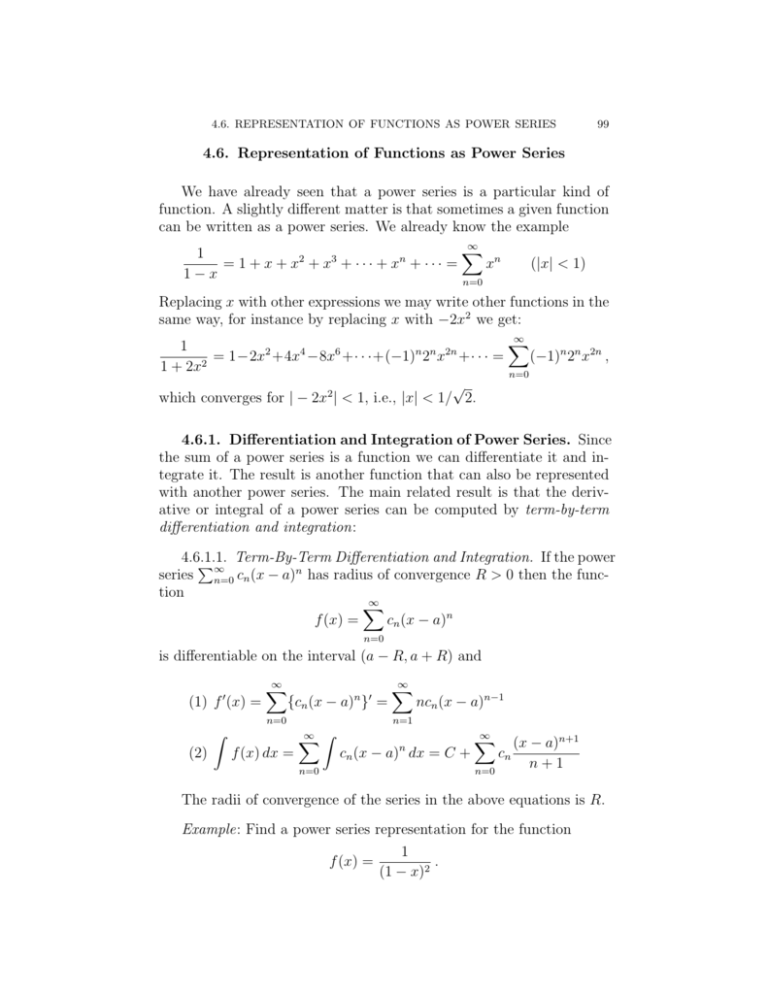
4.6. REPRESENTATION OF FUNCTIONS AS POWER SERIES
99
4.6. Representation of Functions as Power Series
We have already seen that a power series is a particular kind of
function. A slightly different matter is that sometimes a given function
can be written as a power series. We already know the example
∞
X
1
2
3
n
= 1 + x + x + x + ··· + x + ··· =
xn
(|x| < 1)
1−x
n=0
Replacing x with other expressions we may write other functions in the
same way, for instance by replacing x with −2x2 we get:
∞
X
1
2
4
6
n n 2n
=
1−2x
+4x
−8x
+·
·
·+(−1)
2
x
+·
·
·
=
(−1)n 2n x2n ,
1 + 2x2
n=0
√
which converges for | − 2x2 | < 1, i.e., |x| < 1/ 2.
4.6.1. Differentiation and Integration of Power Series. Since
the sum of a power series is a function we can differentiate it and integrate it. The result is another function that can also be represented
with another power series. The main related result is that the derivative or integral of a power series can be computed by term-by-term
differentiation and integration:
4.6.1.1.
Differentiation and Integration. If the power
P Term-By-Term
n
series ∞
c
(x
−
a)
has
radius
of convergence R > 0 then the funcn
n=0
tion
∞
X
f (x) =
cn (x − a)n
n=0
is differentiable on the interval (a − R, a + R) and
(1) f 0 (x) =
Z
(2)
∞
X
{cn (x − a)n }0 =
n=0
f (x) dx =
∞ Z
X
n=0
∞
X
ncn (x − a)n−1
n=1
cn (x − a)n dx = C +
∞
X
n=0
cn
(x − a)n+1
n+1
The radii of convergence of the series in the above equations is R.
Example: Find a power series representation for the function
1
f (x) =
.
(1 − x)2
4.6. REPRESENTATION OF FUNCTIONS AS POWER SERIES
100
Answer : We have
1
d 1
=
2
(1 − x)
dx 1 − x
and
X
1
xn ,
=
1 − x n=0
∞
hence
1
d X n X d n X n−1
x =
=
x =
nx
(1 − x)2
dx n=0
dx
n=0
n=1
∞
∞
∞
∞
X
= 1 + 2x + 3x + 4x + · · · =
(n + 1)xn
2
3
(re-indexed)
n=0
The radius of convergence is R = 1.
Example: Find a power series representation for tan−1 x.
Answer : That function is the antiderivative of 1/(1 + x2 ), hence:
Z
1
−1
tan x =
dx
1 + x2
Z X
∞
=
(−1)n x2n dx
n=0
=
∞ Z
X
(−1)n x2n dx
n=0
∞
X
x2n+1
(−1)n
=C+
2n + 1
n=0
=C +x−
x3 x5 x7
+
−
+ ...
3
5
7
Since tan−1 0 = 0 then C = 0, hence
−1
tan
x=
∞
X
n=0
(−1)n
x 3 x5 x 7
x2n+1
=x−
+
−
+ ...
2n + 1
3
5
7
The radius of convergence is R = 1.
Example: Find a power series representation for ln (1 + x).
4.6. REPRESENTATION OF FUNCTIONS AS POWER SERIES
Answer : The derivative of that function is 1/(1 + x), hence
Z
1
dx
ln (1 + x) =
1+x
Z X
∞
=
(−1)n xn dx
n=0
∞ Z
X
=C+
n=0
=C +x−
(−1)n
xn+1
dx
n+1
x2 x3 x4
+
−
+ ···
2
3
4
Since ln 1 = 0 then C = 0, so
X
x2 x3 x4
xn
(−1)n+1
+
−
+ ··· =
2
3
4
n
n=1
∞
ln (1 + x) = x −
The radius of convergence is R = 1.
101
